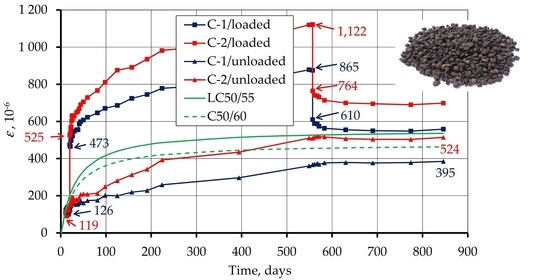Experimental Evaluation of Shrinkage, Creep and Prestress Losses in Lightweight Aggregate Concrete with Sintered Fly Ash
Abstract
:1. Introduction
2. Background
2.1. Properties of Lightweight Concrete
2.2. Creep and Shrinkage Research
2.3. Research Gap
3. Materials and Methods
3.1. Lightweight Aggregate
3.2. Concrete Mixtures
3.3. Test of Concrete Strength Properties
3.4. Creep and Shrinkage Test
4. Results and Discussion
4.1. Concrete Strength and Modulus of Elasticity
4.2. Air Condition
4.3. Strains of Loaded and Unloaded Specimens
4.4. Strains Under the Load
4.5. Creep Coefficient
4.6. Prestress Losses
4.7. Limitations of the Study
4.8. Research Profits
5. Conclusions
- The concrete made exhibited a lower shrinkage than that obtained from the calculations in accordance with the Eurocode 2 [36], for the assumed mixture parameters and test conditions as well as than that obtained from foreign research of concretes with other artificial lightweight aggregates;
- The tested concrete exhibited a very low creep coefficient in the considered period. The creep coefficient value was 0.610 and 0.537, which is 56.0 and 49.3% of the value determined from the standard [36]. It is also far less than that obtained from foreign research on concretes with other artificial lightweight aggregates. The creep rate is very fast, 95% of the creep registered after 539 days had already occurred in the first 200 days;
- The concrete showed clearly viscous behavior and high residual strain;
- The prestressing losses in the analyzed period amounted to an average of 13.0% (maximum 16.2%), which is an acceptable value and does not discriminate against concrete being used for prestressing.
Author Contributions
Funding
Institutional Review Board Statement
Informed Consent Statement
Data Availability Statement
Acknowledgments
Conflicts of Interest
References
- Singh, A.; Pal, S. Lightweight Concrete a Boon in Civil Engineering-Review. J. Civ. Eng. Environ. Technol. 2015, 2, 451–455. [Google Scholar]
- Sari, D.; Pasamehmetoglu, A.G. The effects of gradation and admixture on the pumice lightweight aggregate concrete. Cem. Concr. Res. 2005, 35, 936–942. [Google Scholar] [CrossRef]
- Robinson, H.C.; Ayres, R.A.; Erskine, F.G.; Barton, S.G.; Faber, J.; Bremner, T.; Gorsline, L.; Brooks, W.I.; Hanson, J.A.; Carter, A.C.; et al. Guide for Structural Lightweight Aggregate Concrete ACI213R87; American Concrete Institute: Farmington Hills, MI, USA, 1999. [Google Scholar]
- Szydłowski, R.; Mieszczak, M. Study of application of lightweight aggregate concrete to construct posttensioned long-span slabs. Procedia Eng. 2017, 172, 1077–1085. [Google Scholar] [CrossRef]
- Buckman, R.W.; Elia, G.G.; Ichikawa, Y. Lightweight concrete materials and structural systems for water tanks for thermal storage. In Final Report of Westinghouse Electric Corp; Westinghouse Electric Corp.: Pittsburgh, PA, USA, 1980. [Google Scholar]
- Tian, Y.; Shi, S.; Jia, K.; Hu, S. Mechanical and dynamic properties of high strength concrete modified with lightweight aggregates presaturated polymer emulsion. Constr. Build. Mater. 2015, 93, 1151–1156. [Google Scholar] [CrossRef]
- Lotfy, A.; Hossain, K.M.; Lachemi, M. Durability properties of lightweight self-consolidating concrete developed with three types of aggregates. Constr. Build. Mater. 2016, 106, 43–54. [Google Scholar] [CrossRef]
- Domagała, L. Structural Lightweight Aggregate Concretes; Cracow University of Technology Publishing House: Cracow, Poland, 2014. [Google Scholar]
- Ganapathy, M. Lightweight Concrete and the New Benica-Martinez Bridge. Concr. Bridge Views 2008, 49, 1–13. [Google Scholar]
- Szydłowski, R.; Łabuzek, B. Post-tensioned concrete long-span slabs in projects of modern building construction. In Proceedings of the IOP Conference Series: Materials Science and Engineering, Prague, Czech Republic, 12–16 June 2017; Volume 245, p. 022065. [Google Scholar] [CrossRef]
- Szydłowski, R.; Łabuzek, B.; Rodacka, M. Concrete floors in buildings post-tensioned with unbonded tendons. History, design recommendations, realizations, possibilities of improvement. In Concrete Innovations in Materials, Design and Structures, Proceedings of the 2019 fib International Symposium, Cracow, Poland, 27–29 May 2019; Derkowski, W., Gwoździewicz, P., Hojdys, Ł., Krajewski, P., Pańtak, M., Eds.; Féderation Internationale du Béton: Cracow, Poland, 2019. [Google Scholar]
- Szydłowski, R. Floor Slabs Post-Tensioned with Unbonded Tendons. Theory, Design and Tests; Cracow University of Technology Publishing House: Cracow, Poland, 2019. [Google Scholar]
- Mieszczak, M.; Szydłowski, R. Lightweight concrete in prestressed structures. Builder 2017, 7, 90–93. [Google Scholar]
- Domagała, L. The Influence of the Type of Coarse Aggregate on the Mechanical Properties of Structural Concretes. Sci. J. Rzesz. Univ. Technol. 2011, 3, 299–306. [Google Scholar]
- Zhang, M.; Gjǿrv, O. Mechanical properties of high-strength lightweight concrete. ACI Mater. J. 1991, 88, 240–247. [Google Scholar]
- Clarke, J.L. Structural Lightweight Aggregate Concrete; CRC Press: Boca Raton, FL, USA, 2002. [Google Scholar]
- LRFD Bridge Design Specifications, 6th ed.; American Association of State Highway and Transportation Officials: Washington, DC, USA, 2012.
- Structural LWAC. Specification and Guideline for Materials and Production; Document BE96-3942/R14, Project Funded by the European Union under the Industrial & Materials Technologies Programme (Brite-EuRam III). 2000. Available online: https://www.researchgate.net/publication/339460461_LWAC_Material_Properties_-_State-of-the-Art (accessed on 12 July 2021).
- ACI 213R-03. Guide for Structural Lightweight Aggregate Concrete; American Concrete Institute: Farmington Hills, MI, USA, 2003. [Google Scholar]
- Lopez, M.; Kahn, L.; Kurtis, K.; Lai, J. Creep, Shrinkage, and Prestress Losses of High-Performance Lightweight Concrete; GDOT Research Project No. 2004; Office of Materials and Research Georgia Department of Transportation: Atlanta, GA, USA, 2003. [Google Scholar]
- Lopez, M.; Kurtis, K.; Kahn, L. Pre-wetted lightweight coarse aggregate reduces long-term deformations of high performance lightweight concrete. In Proceedings of the 7th CANMET/ACI International Conference on Durability of Concrete, SP-234, Montreal, QC, Canada, 28 May–3 June 2006. [Google Scholar]
- Nielsen, U.; Aïtcin, P. Properties of high-strength concrete containing light-, normal- and heavy-weight aggregate. Cem. Concr. Aggreg. 1992, 14, 8–12. [Google Scholar] [CrossRef]
- Chandra, S.; Berntsson, L. Lightweight Aggregate Concrete; NJ Noyes Publications: Norwich, UK, 2003. [Google Scholar]
- Domagała, L. Shrinkage and swelling of lightweight aggregate concretes modified with fiber phase. Tech. Trans. 2008, Z1-B, 21–40. [Google Scholar]
- Kayali, O.; Haque, M.; Zhu, B. Drying shrinkage of fibre-reinforced lightweight aggregate concrete containing fly ash. Cem. Concr. Res. 1999, 29, 1835–1840. [Google Scholar] [CrossRef]
- Khandaker, M. Properties of volcanic pumice based cement and lightweight concrete. Cem. Concr. Res. 2004, 34, 283–291. [Google Scholar]
- Liu, X.; Yang, Y.; Jiang, A. The Influence of Lightweight Aggregate on the Shrinkage of Concrete; CEB/FIP International Symposium on Structural Lightweight Aggregate Concrete: Sandefjord, Norway, 1995; pp. 555–562. [Google Scholar]
- Best, C.H.; Polivka, M. Creep of lightweight concrete. Mag. Concr. Res. 1959, 11, 129–134. [Google Scholar] [CrossRef]
- Pfeifer, D.W. Sand replacement in structural lightweight concrete-creep and shrinkage studies. ACI J. Proc. 1968, 65, 131–140. [Google Scholar]
- Lopez, M.; Kahn, L.F.; Kurtis, K.E. Creep and shrinkage of high-performance lightweight concrete. ACI Mater. J. 2004, 101, 391–399. [Google Scholar]
- Lopez, M. Creep and Shrinkage of High Performance Lightweight Concrete: A Multi Scale Investigation, Doctoral Dissertation; Georgia Institute of Technology: Atlanta, GA, USA, 2005. [Google Scholar]
- Wendling, A.; Sadhasivam, K.; Floyd, R.W. Creep and shrinkage of lightweight self-consolidationg concrete for prestressed members. Constr. Build. Mater. 2018, 167, 205–215. [Google Scholar] [CrossRef]
- Wang, Z.; Li, X.; Jiang, L.; Wang, M.; Xu, O.; Harries, K. Long-term performance of lightweight aggregate reinforced concrete beams. Constr. Build. Mater. 2020, 264, 1–11. [Google Scholar] [CrossRef]
- Lukin, M.V.; Popov, M.V.; Lisyatnikow, M.S. Short-Term and Long-Term Deformations of the Lightweight Concrete. IOP Conf. Ser. Mater. Sci. Eng. 2020, 753, 032071. [Google Scholar] [CrossRef]
- Łuczaj, K.; Urbańska, P. Certyd—New, light, high-strength sintered aggregate. Mater. Bud. 2015, 12, 42–45. [Google Scholar]
- European Committee of Standardization. EN 1992-1-1: Eurocode 2: Design of Concrete Structures—Part 1-1: General Rules and Rules for Buildings; European Committee of Standardization: Brussels, Belgium, 2004. [Google Scholar]
- Szydłowski, R. Concrete properties for long-span post-tensioned slabs. Mater. Sci. Forum 2018, 296, 122–127. [Google Scholar] [CrossRef]
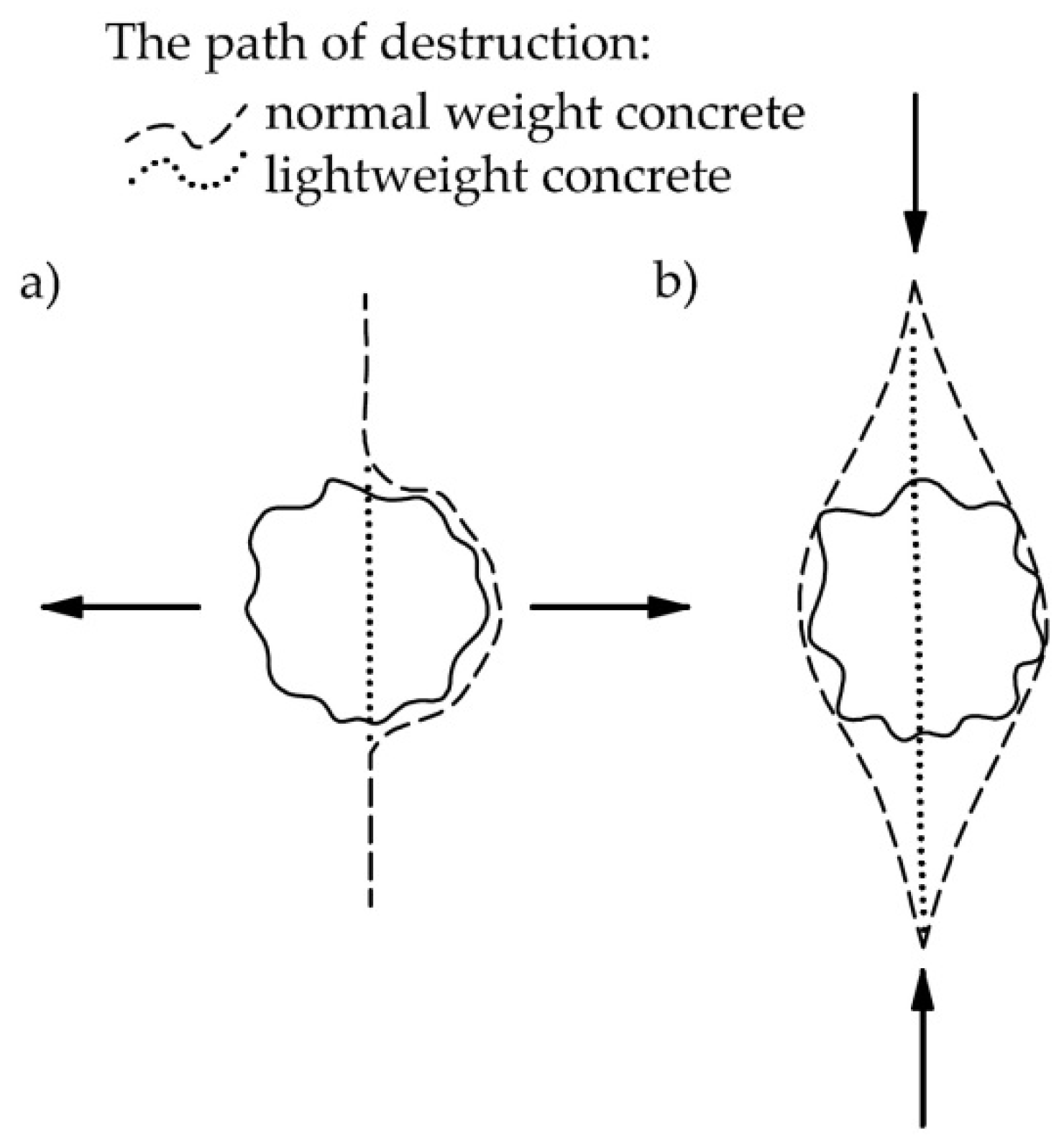
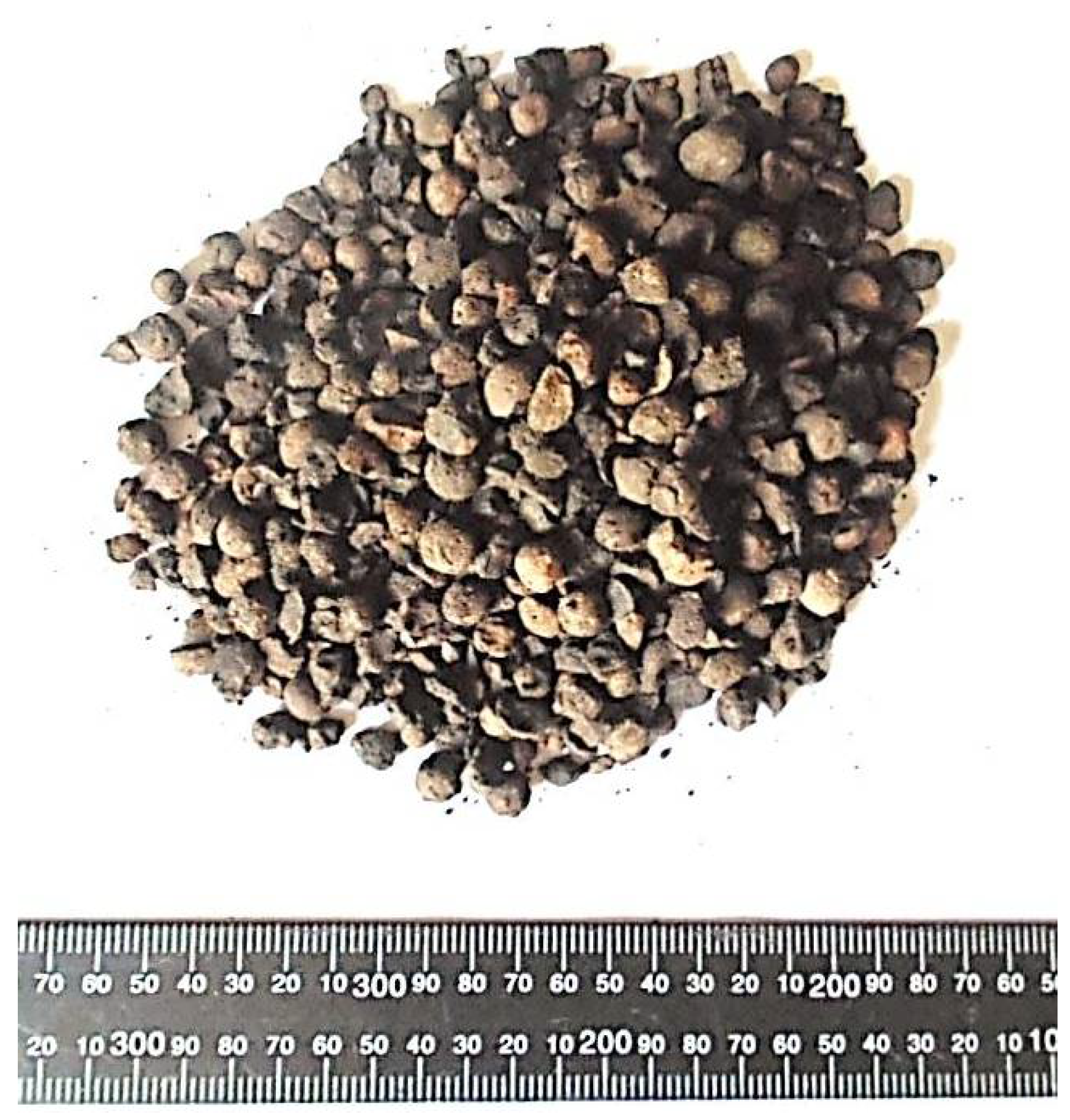
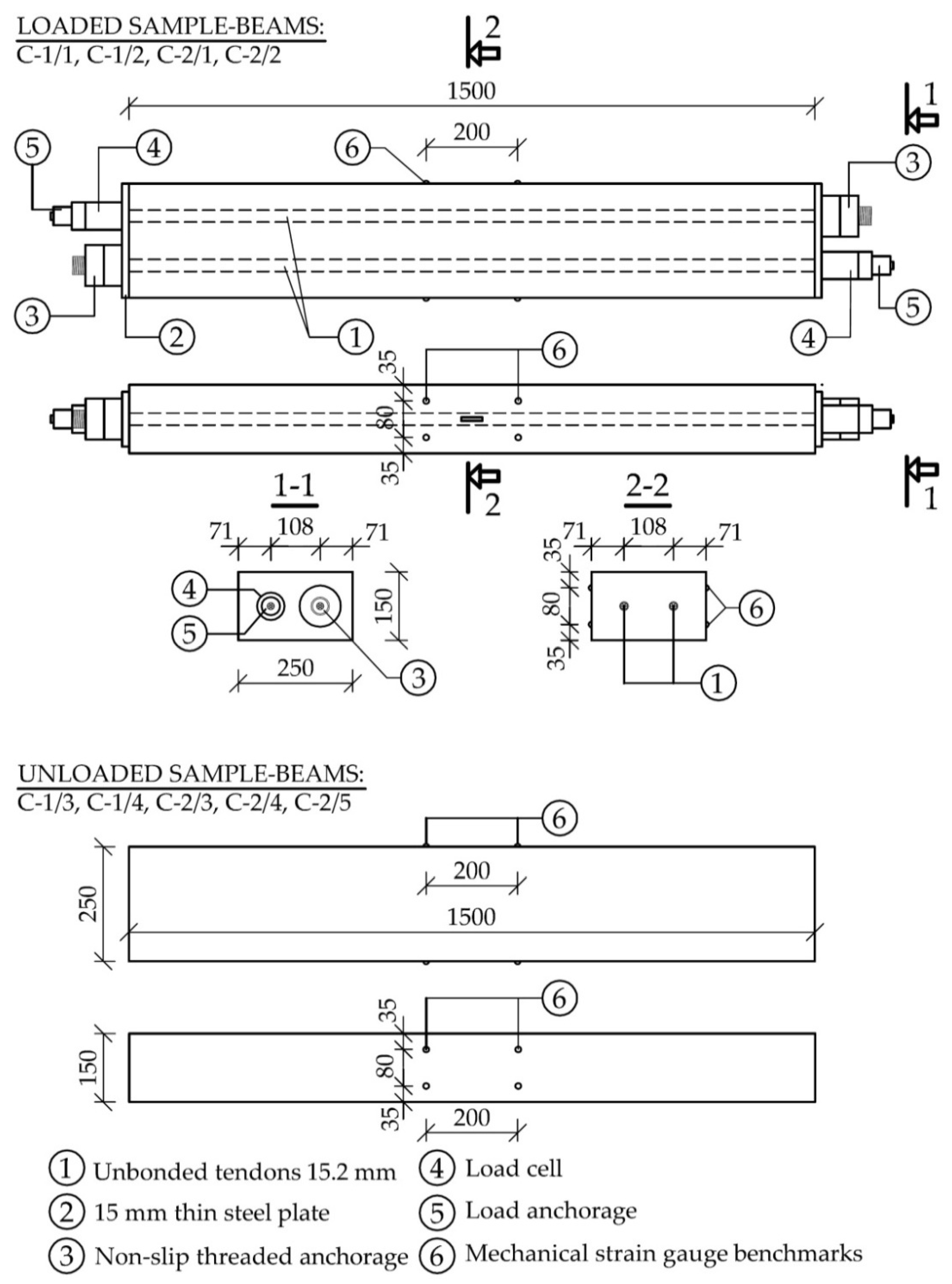
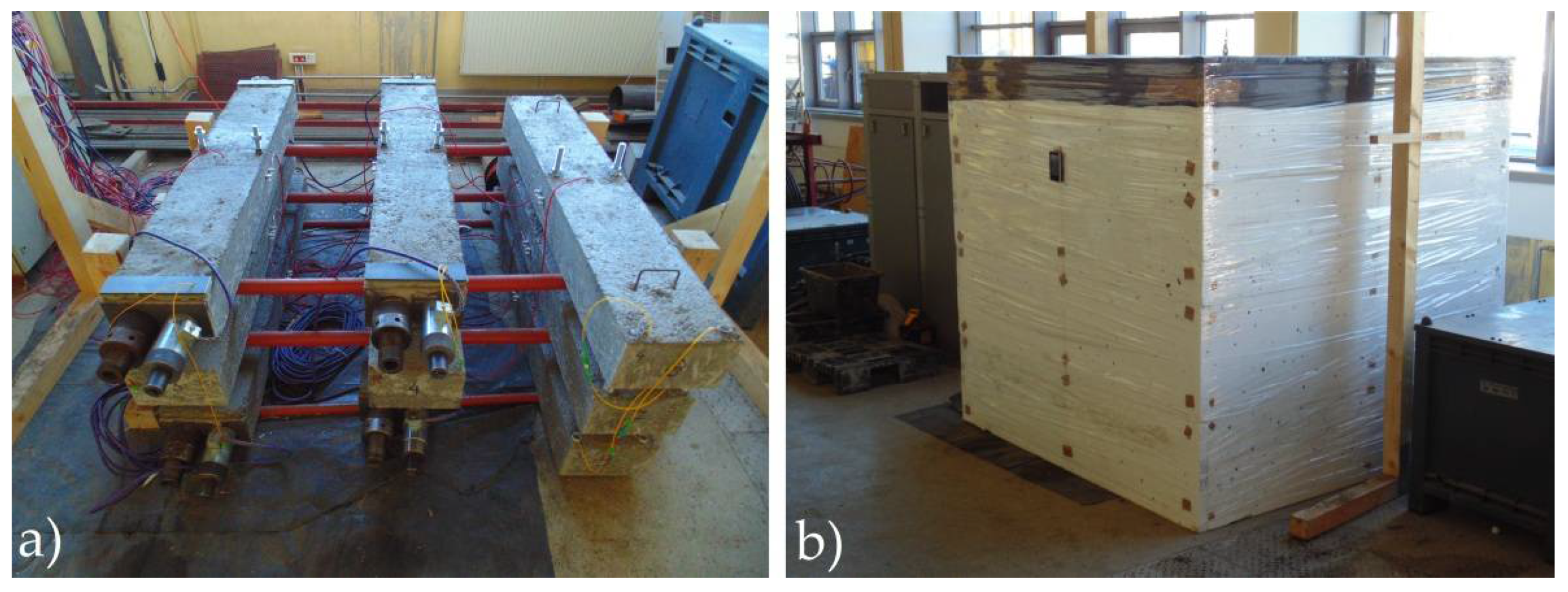
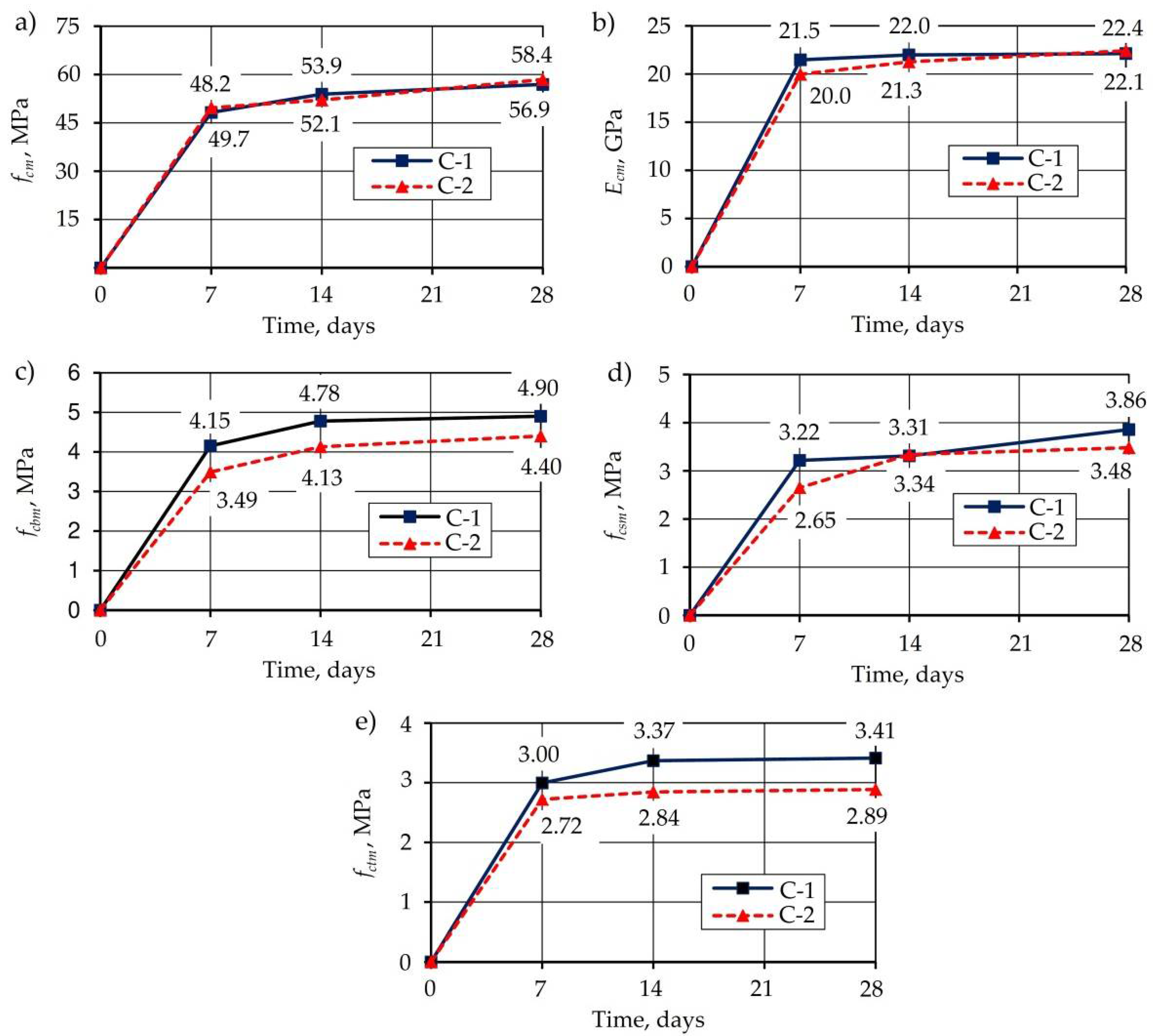
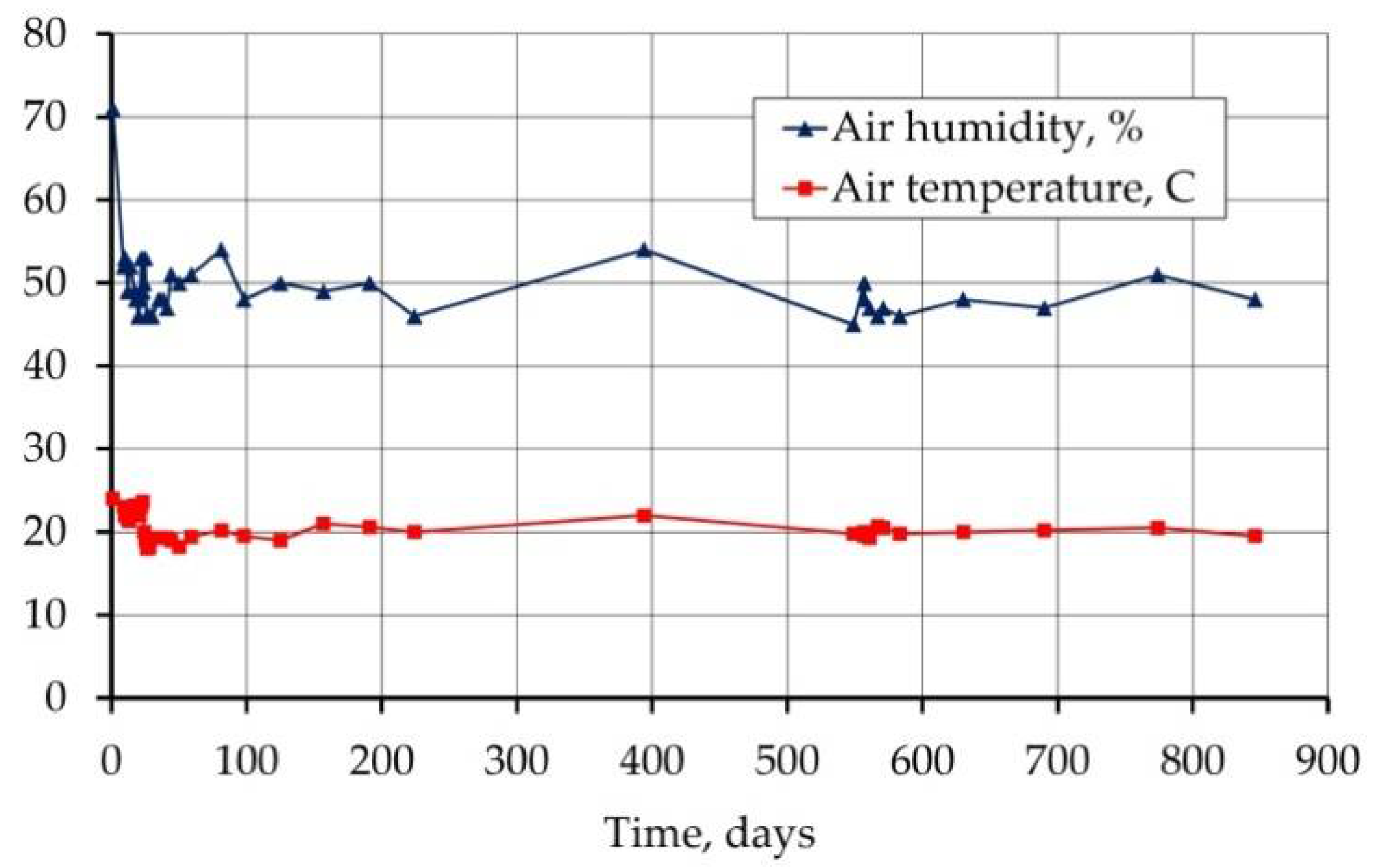

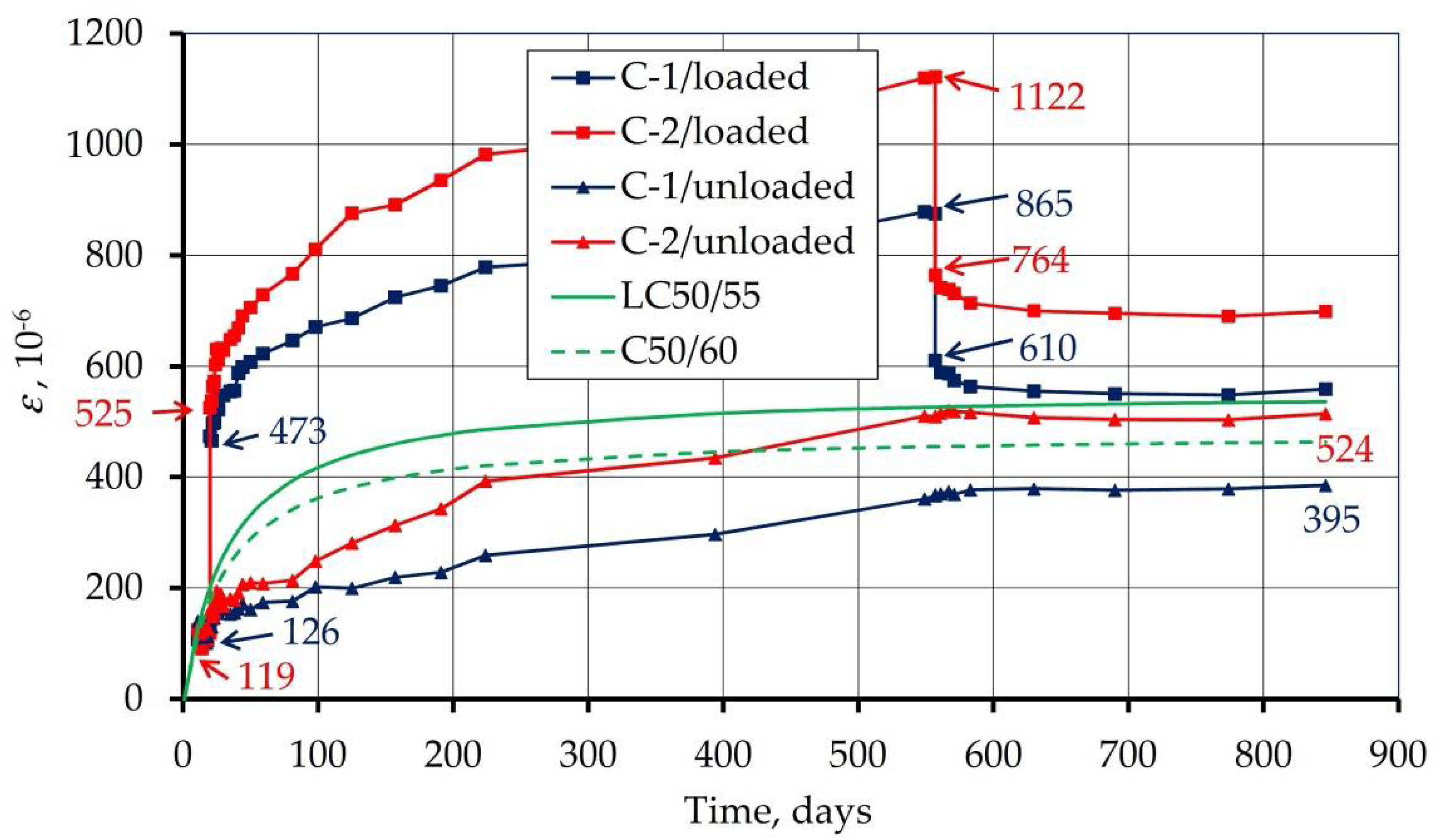
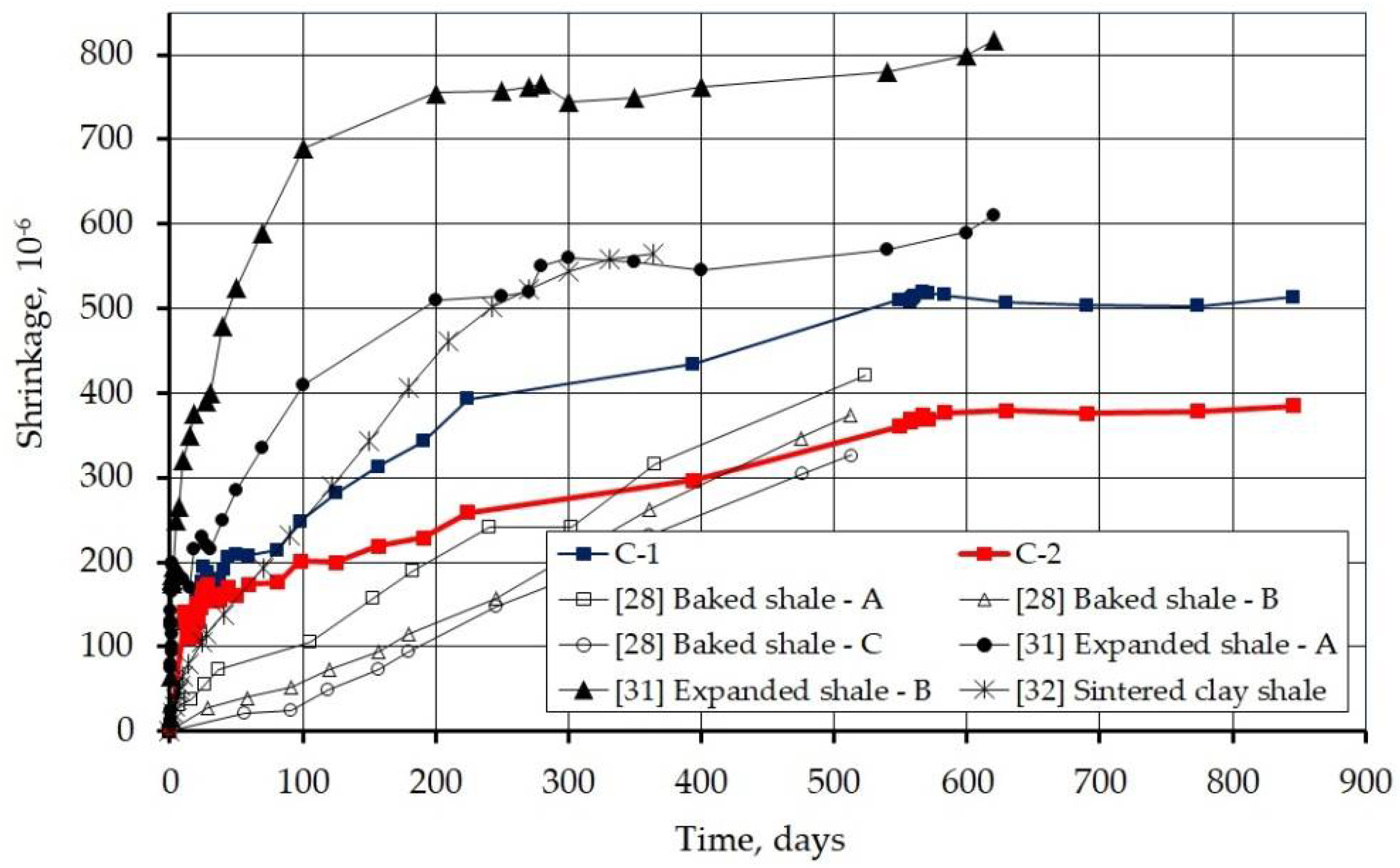
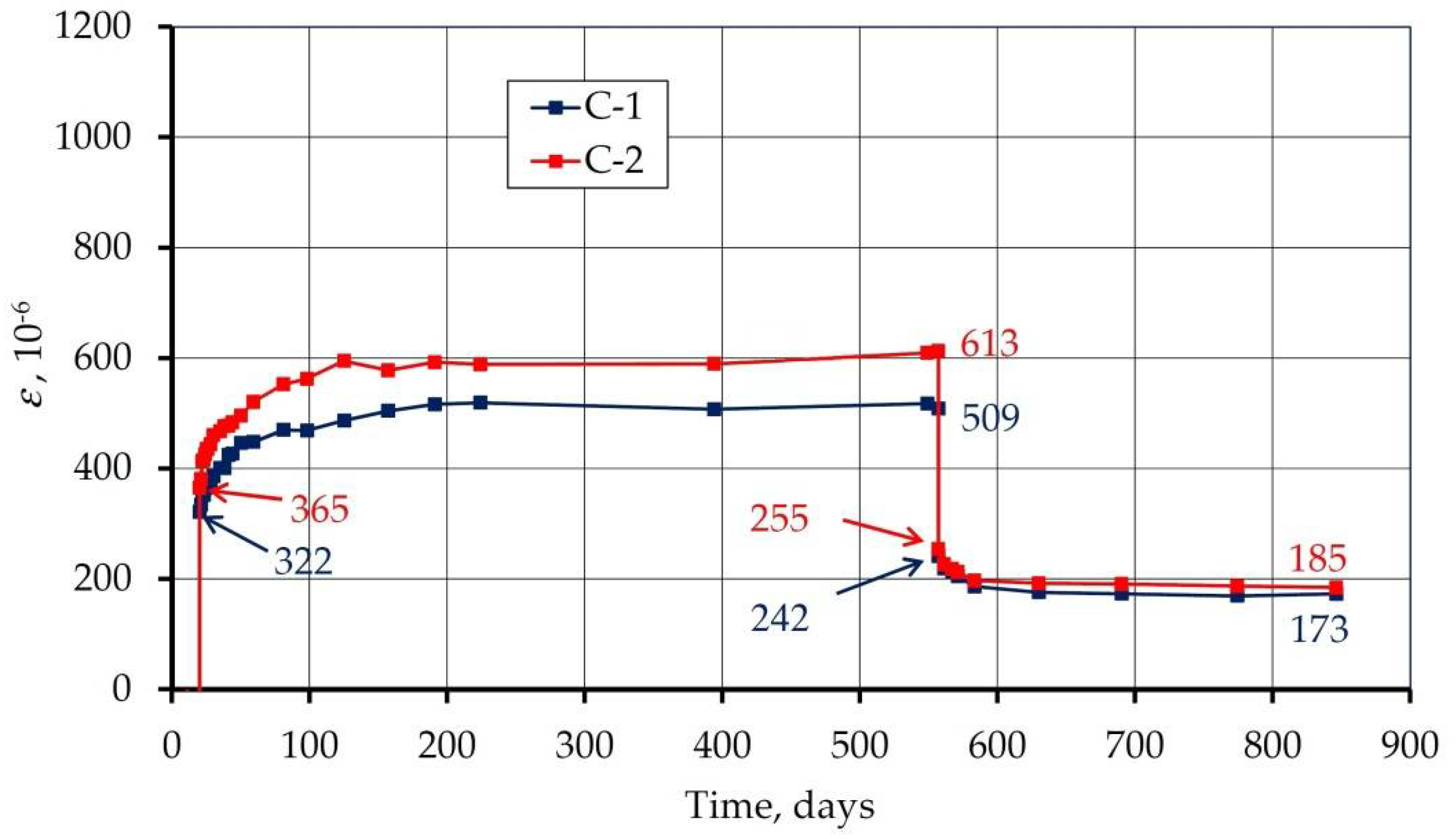
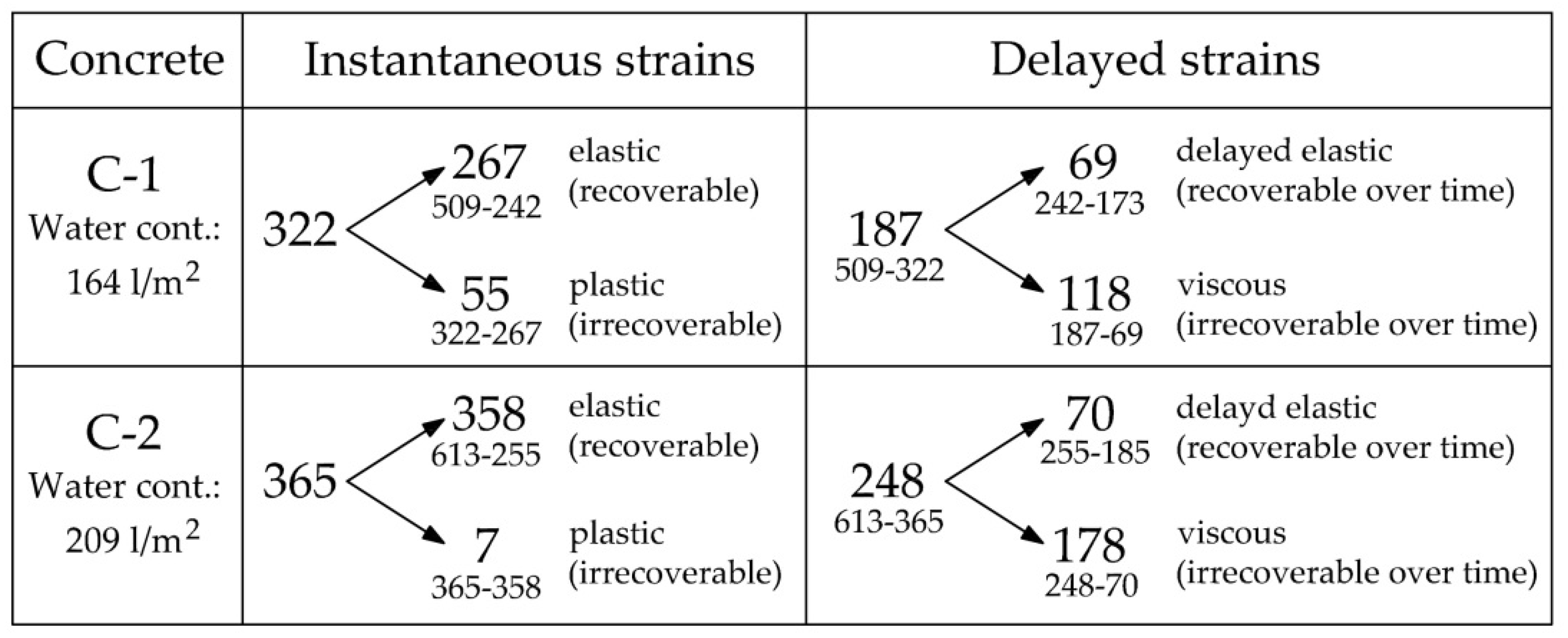
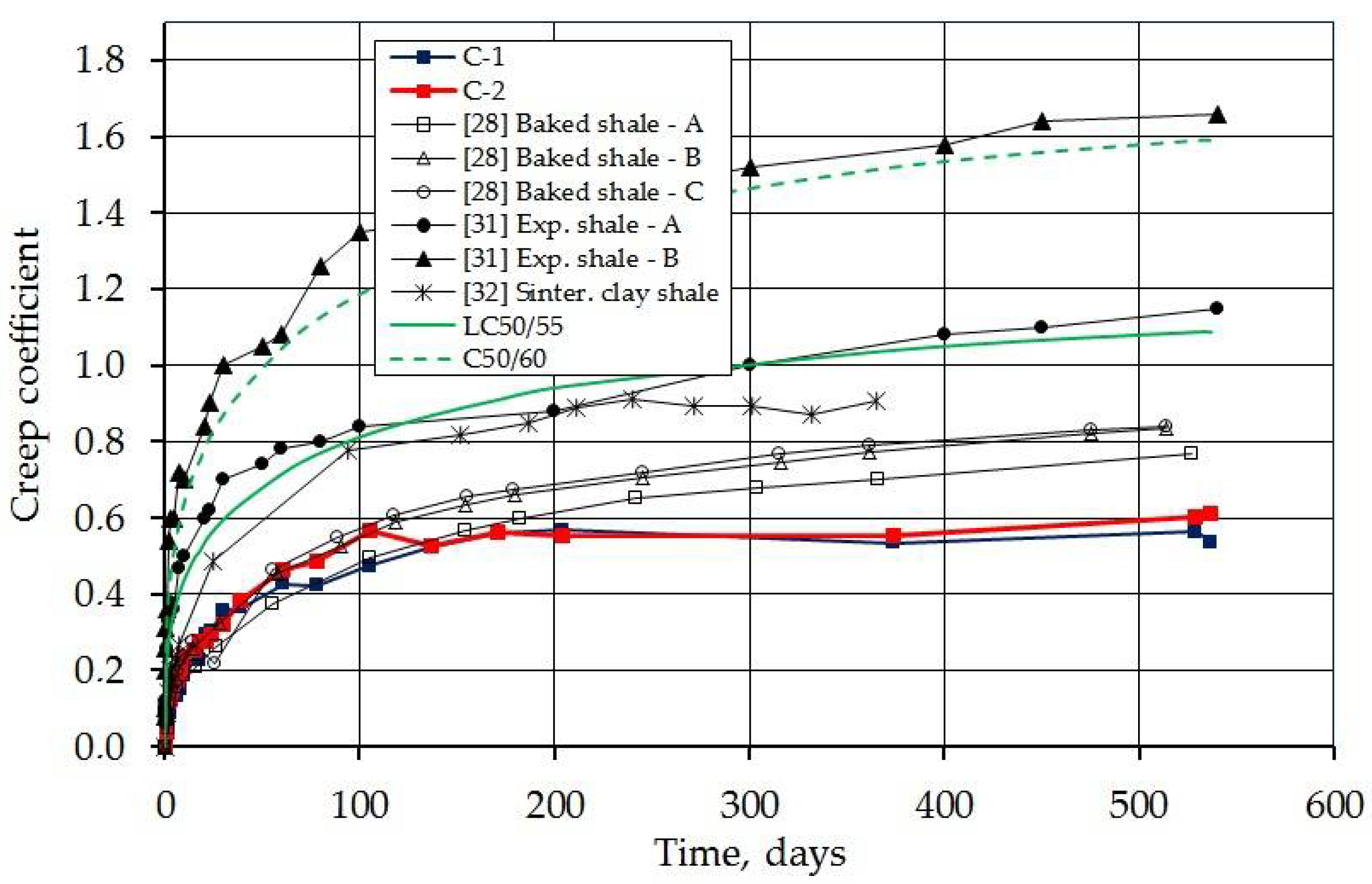

| Research | Lightweight Aggregate | Concrete Strength MPa | Loading AgeDay | Samples Number | Load Time Days |
|---|---|---|---|---|---|
| Best and Polivka 1959 [28] | Baked shale | 20.7 | - | 4 | 520 |
| 34.5 | 3 | ||||
| Pfeifer 1968 [29] | Expanded blast furnace slag | 20.7 34.5 | 7 | - | 730 |
| Expanded shale produced in a rotary kiln | |||||
| Expanded shale produced on a sintering grate | |||||
| Expanded clay produced on a sintering grate | |||||
| Lopez, Kahn and Kurtis 2004 [30] | Expanded shale | 55.0 69.0 | 16 | 8 | 620 |
| Lopez 2005 [31] | Pre-soaked extended shale | Shrinkage and creep were not separated, the creep is provided based on the DIC technique | |||
| Wendling, Sadhasivam and Floyd 2018 [32] | Expanded shale | 28.0 | 1 28 | 4 | 365 |
| Wang, Li, Jiang, Wang, Xu and Harries 2020 [33] | Expanded clay | 25.1 ÷ 24.8 | 28 | 16 large scale RC and PT beams | 20–30 years |
| Sintered pulverized fuel ash | |||||
| Lukin, Popov and Lisyatnikov 2020 [34] | Expanded clay | 10÷60 | 28 | - | 700 |
| Expanded perlite | |||||
| Agloporite | |||||
| Feature | Code | Fraction | |||
|---|---|---|---|---|---|
| 0/2 | 2/4 | 4/8 | 8/16 | ||
| Bulk density, kg/m3 | PN-EN 1097-3 | 930–990 | 600–630 | 650–750 | 740–750 |
| Grain density, kg/m3 | PN-EN 1097-6 | - | - | 1350–1430 | 1350–1430 |
| Water absorption after 12 h, % | PN-EN 1097-6 | - | - | 17 | 16 |
| Crush resistance, MPa | PN-EN 13055-1 | - | - | 6–10 | 6–8 |
| Frost resistance, % | NP-EN 13055-1 | - | - | ≤1 | ≤1 |
| Component | C-1 | C-2 | |
|---|---|---|---|
| kg/m3 | kg/m3 | ||
| Cement CEM I 42.5 N | 409 | 419 | |
| Aggregate Certyd (4–12 mm) | 775 | 802 | |
| Sand | 682 | 703 | |
| Water | 164 | 209 | |
| Additions | BV 18 | 3,7 | 3,8 |
| SKY 686 | 3,7 | 3,8 | |
| Weight of wet mixture | 2039 | 2142 | |
| Concrete density | 1810 | 1820 | |
| W/C | 0.41 | 0.51 | |
| Concrete | Specimen | Initial Stress, MPa |
|---|---|---|
| C-1 | C-1/1 | 9.7 |
| C-1/2 | 11.0 | |
| C-1/3 | - | |
| C-1/4 | - | |
| C-2 | C-2/1 | 9.0 |
| C-2/2 | 9.9 | |
| C-2/3 | - | |
| C-2/4 | - | |
| C-2/5 | - |
| Feature | Unit | Required | Test Results | |
|---|---|---|---|---|
| C-1 | C-2 | |||
| flcm | MPa | 58 | 56.9 | 58.4 |
| Elcm | GPa | 25.3 | 22.1 | 22.4 |
| flctm | MPa | 3.67 | 3.86 | 3.48 |
Publisher’s Note: MDPI stays neutral with regard to jurisdictional claims in published maps and institutional affiliations. |
© 2021 by the authors. Licensee MDPI, Basel, Switzerland. This article is an open access article distributed under the terms and conditions of the Creative Commons Attribution (CC BY) license (https://creativecommons.org/licenses/by/4.0/).
Share and Cite
Szydłowski, R.S.; Łabuzek, B. Experimental Evaluation of Shrinkage, Creep and Prestress Losses in Lightweight Aggregate Concrete with Sintered Fly Ash. Materials 2021, 14, 3895. https://doi.org/10.3390/ma14143895
Szydłowski RS, Łabuzek B. Experimental Evaluation of Shrinkage, Creep and Prestress Losses in Lightweight Aggregate Concrete with Sintered Fly Ash. Materials. 2021; 14(14):3895. https://doi.org/10.3390/ma14143895
Chicago/Turabian StyleSzydłowski, Rafał Stanisław, and Barbara Łabuzek. 2021. "Experimental Evaluation of Shrinkage, Creep and Prestress Losses in Lightweight Aggregate Concrete with Sintered Fly Ash" Materials 14, no. 14: 3895. https://doi.org/10.3390/ma14143895
APA StyleSzydłowski, R. S., & Łabuzek, B. (2021). Experimental Evaluation of Shrinkage, Creep and Prestress Losses in Lightweight Aggregate Concrete with Sintered Fly Ash. Materials, 14(14), 3895. https://doi.org/10.3390/ma14143895





